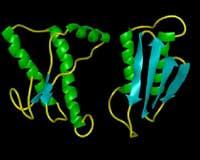Prions against prions in computers
Mad cow disease (bovine spongiform encephalopathy) is caused by small proteins called prions. As in other diseases of the same type, such as sheep scrapie and human disease Creutzfeld-Jacob, the attitude of prions ‘deteriorates’ the proteins of the environment and the brain cannot function properly.

Proteins are molecules in the form of a chain that, by bad folding, cannot fulfill their function. According to scientists, prions attract and deform healthy proteins. Thus, the disease occurs when clusters of about five poorly folded proteins are accumulated around a prion.
Other proteins are stored in this area and the lump increases. By increasing the lump, having more skin, more protein is added to the whole and the disease spreads faster.
External assistance
American scientists invent a strategy to deal with the problem. The case of mice and hamsters is not strange to them. The prion that causes the disease in the mouse also affects the hamsters, but the opposite does not happen.
The incorporation of Hamster prions into mice has allowed calculating through computers that in the mouse the disease would develop more slowly. According to scientists, this same effect could be effective in other animals.
This effect would not eliminate the disease, but would slow it down much. Thus, if in the cows delayed the development of the disease thirty years, the development cow would be dead and there would be no problems.
This strategy is still up to the calculation of computers. However, these calculations cannot make a concrete model of reality, so each and every variable has not been taken into account. However, it is a surprising new strategy that could strengthen research against prions.
Buletina
Bidali zure helbide elektronikoa eta jaso asteroko buletina zure sarrera-ontzian











